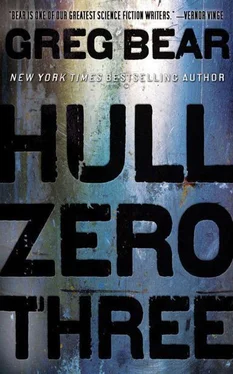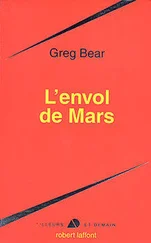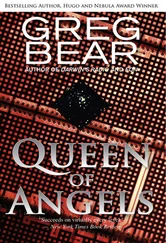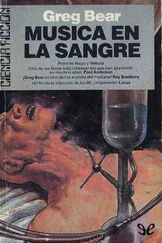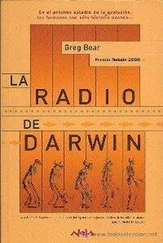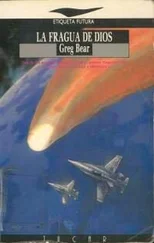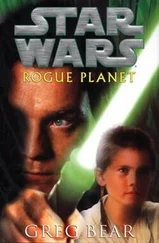“He’s not the one for you,” the boy says to her, having watched with a detached expression. “The hull made him that way. It will never be you.”
“Shut up,” the woman says.
“ You shut up,” the boy says.
The woman clears her throat. The boy gets up and places his ear against the space where the door was. He moves his hands again. Turns and smiles. The door opens. The hall beyond is quiet and empty. “They’ve gone,” the boy says.
“What were they?” I ask.
“Factors,” the boy says. “I get a feeling when they’re coming. I close the door and they pass us by.”
The woman stares into a corner. “You’ll leave now,” she says. “It’s what you always do. You read your book and then you leave. And they bring you back.” She shudders in something like resignation, maybe more like despair. “Don’t go out there. Out there is nothing but death and misery. You could stay here. There’s food and water, and we could pass the time. Talk is what I miss the most.”
But it’s clear I’ve made up my mind.
“Next time, if there’s a book, don’t give it to him,” the boy suggests.
The woman gets up. “Well, at least let me put together a bag of food and water.” She looks at the boy, who nods permission. Here, he is the master. The woman is just another piece of furniture.
It really is time for me to leave.
The boy seems glad that I’m moving on. He’s happy to give instruction. Make a run down the hall that passes the freezers while there’s still weight, he says—it should get warmer on the other side.
I do. I barely make it.
Spin-down finds me having to choose between a shaft that points inboard—with a ladder on one side—or a split in the corridor a few meters forward that stretches left and right, concentric with the outer hull, I presume—and there’s no way of knowing whether the corridor circles around, bringing me back here, or branches off somewhere—in other words, whether left and right are ultimately the same or lead to places very different.
With what leisure I have, I pause to analyze some of the faint markings at this juncture: more circular radiances and stripy patterns. No idea what they mean. They’re probably not for me. More likely, they’re ways to guide factors.
What’s obvious to me now is that very little of the hull is prepared for human habitation. All that I’ve seen so far has a sort of useful logic if you’re a factor, intent on specific duties and with little or no curiosity. But more senseless monotony will certainly push me into eccentricity.
I might just return to the Land of the Loaf-Eaters.
For some reason, that brings a smile. I’ve twisted words and made a joke, but I don’t know the original behind what I’ve twisted.
I take out the book and the pencil and think about writing down my joke, to add some levity to a very serious tome. I leaf through the pages, finger the black lines—and only now does the obvious occur to me: what the broad slashes mean. They’re transitions. A new hand writes after each slash.
This makes my joke more than trivial. I close the book and put away the pencil. This book has been carried by at least four of me. If it gets lost, then those who came before might as well have never lived.
How many bodies were brought back to the freezers without a record of their achievements? The others like me, who wrote in this book, saw things of interest. I hope at least to go as far as they did. I’ll eventually take the opportunity to add notes as I proceed, but there’s no point if I just duplicate what’s already recorded, so…
I haven’t earned the right to add anything yet.
No going back.
I make my choice and descend. I decide to be perverse and use my words counter to the periodic and unreliable up and down . I decide that descent means going inboard toward the core and ascent means moving outboard, toward the skin of the hull.
The “descent” is as before, but I’m getting better at it. I don’t know how far forward along the hull I’ve traveled, but not far enough toward the narrowing bow to make a substantial reduction in the circumference. That might require another kilometer or two. I think it over as I move down the shaft, keeping a lookout for more sketches, more signs of the girl or anybody or anything having made it this far… other than me , of course.
A visit from my own ghost would be strange. I vaguely recall stories of the oracular dead: spirits, hauntings. What if all of me decided to return at once, babbling incoherently? Spooky fables. Useless crap rising up at odd moments. Part of some sort of artificial cultural heritage. Why can’t I retrieve the knowledge I need? The reason and shape behind the Ship—a good schematic. Why three hulls? Why the moon of dirty ice? What, if anything, lives in the other hulls? Is there still someone alive from the Destination Guidance team?
How long has it been? How long since the Ship departed… and where did it depart from? I can think of reasonable answers to some of these questions, but they don’t yet feel convincing.
This much is clear. Ship makes people and stuff as it goes along.
I’m just a youngster.
The shaft behind me is like the shaft below me, a vanishing obscurity. Down, down, downward… hundreds of meters. I pause to drink, but I’m not hungry yet. I had my fill back in the boy’s room. I almost feel guilty partaking of that food, and I feel sorry for the woman in the boy’s thrall.
What did the boy do or give up to find favor with Ship?
There’s a nightmare thought I don’t need to deal with as I hand-over-hand along the rungs.
Spin-up comes, but I’m instinctively prepared. I lock feet and hands on the rungs and wait until things are stable. When I resume, a bottle of water falls out of the bag before I draw the cinch, and I can’t help but watch its twisting, bouncing, accelerating progress into vanishing twilight.
Now it’s a climb in earnest. If I let go and don’t catch myself, I’ll fall down the shaft like the bottle. I’ll bounce and gather speed and… splat.
Another body for the freezer.
Another book for someone to retrieve, with nothing new added.
Is that what the little girls do? Retrieve everyone’s books—Blue-Blacks, Scarlet-Browns, visitors from Destination Guidance?
Descending inboard, always inboard.
After two hours, my fingers and hands have blisters, worse where I touched the frosted cases or laid palms on the freezing deck after I was made. I’m leaving a little blood trail, of which I see no evidence as I climb.
There’s a shadow above—a big one. I pause and lean out to get details, hanging by hands and feet. It’s just a rough black plug higher in the shaft. I climb another dozen meters. The shadow assumes a trilateral outline: a cleaner, about forty yards inboard. It doesn’t move and appears to be stuck. Dead or broken—or patiently waiting. It blocks the rungs at an angle.
I stop and hang for several minutes. I know it’s waiting. It’s a sentinel left in the shaft—not a cleaner, some sort of Killer. A big one, at least, not the little one, which is worse…
I have no idea what any of that means.
Drops of my sweat drip and fall outboard.
Then the black shadow shifts—makes a scraping jerk along one side. The movement so unnerves me I let go of my slippery grip. I fall a few rungs, manage to grab hold again, but wrench my foot.
I see that now the shadow has wedged three broad appendages against the wall of the shaft. Whatever sort of grip a factor might have—suction, friction, like lizard’s feet, it’s coming unstuck. Dead or alive, it’s about to slip loose and drop. All I can do is lay myself tight against the rungs, swing sideways and hang with one hand and one foot flat against the wall.
Читать дальше
